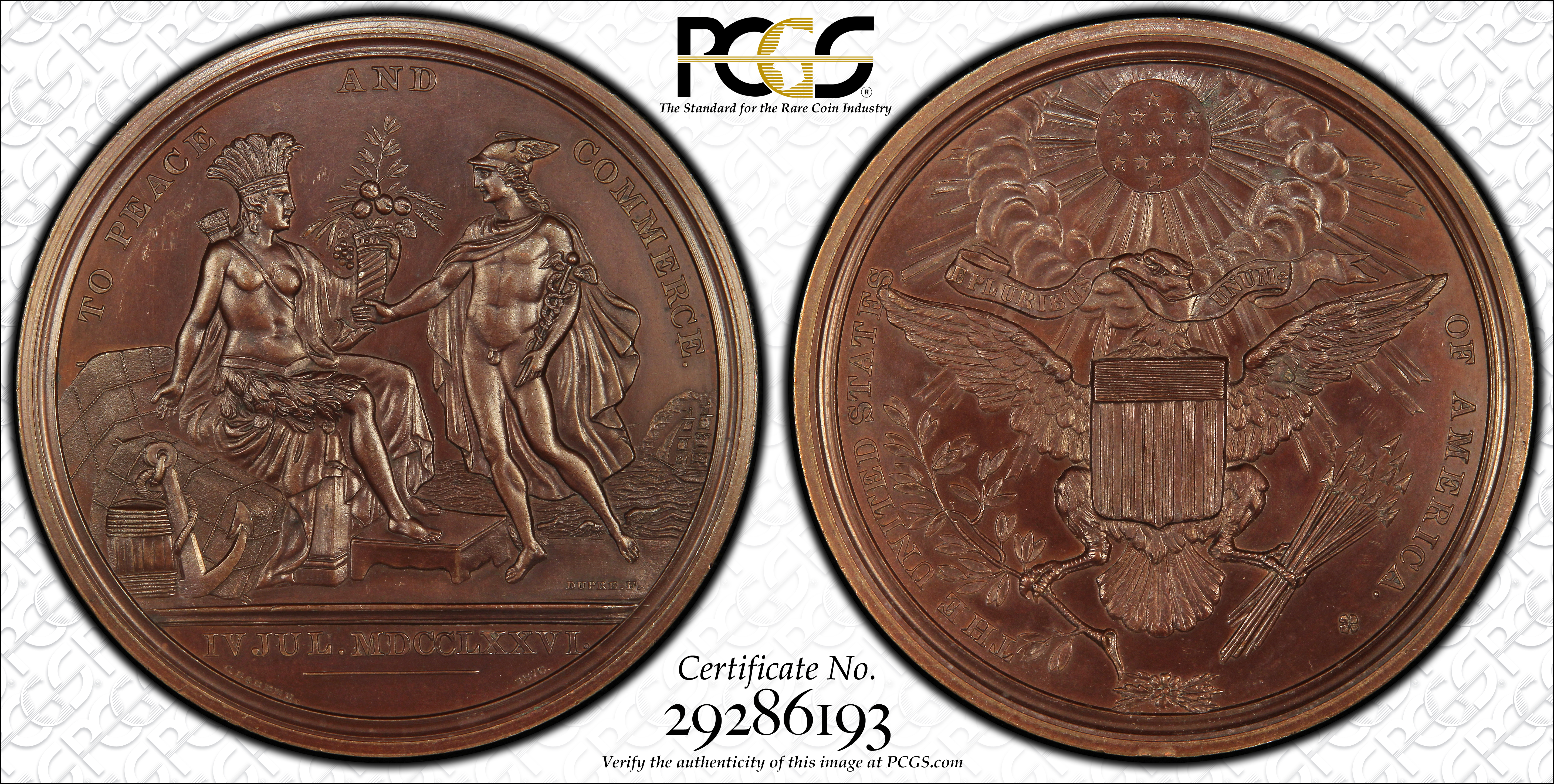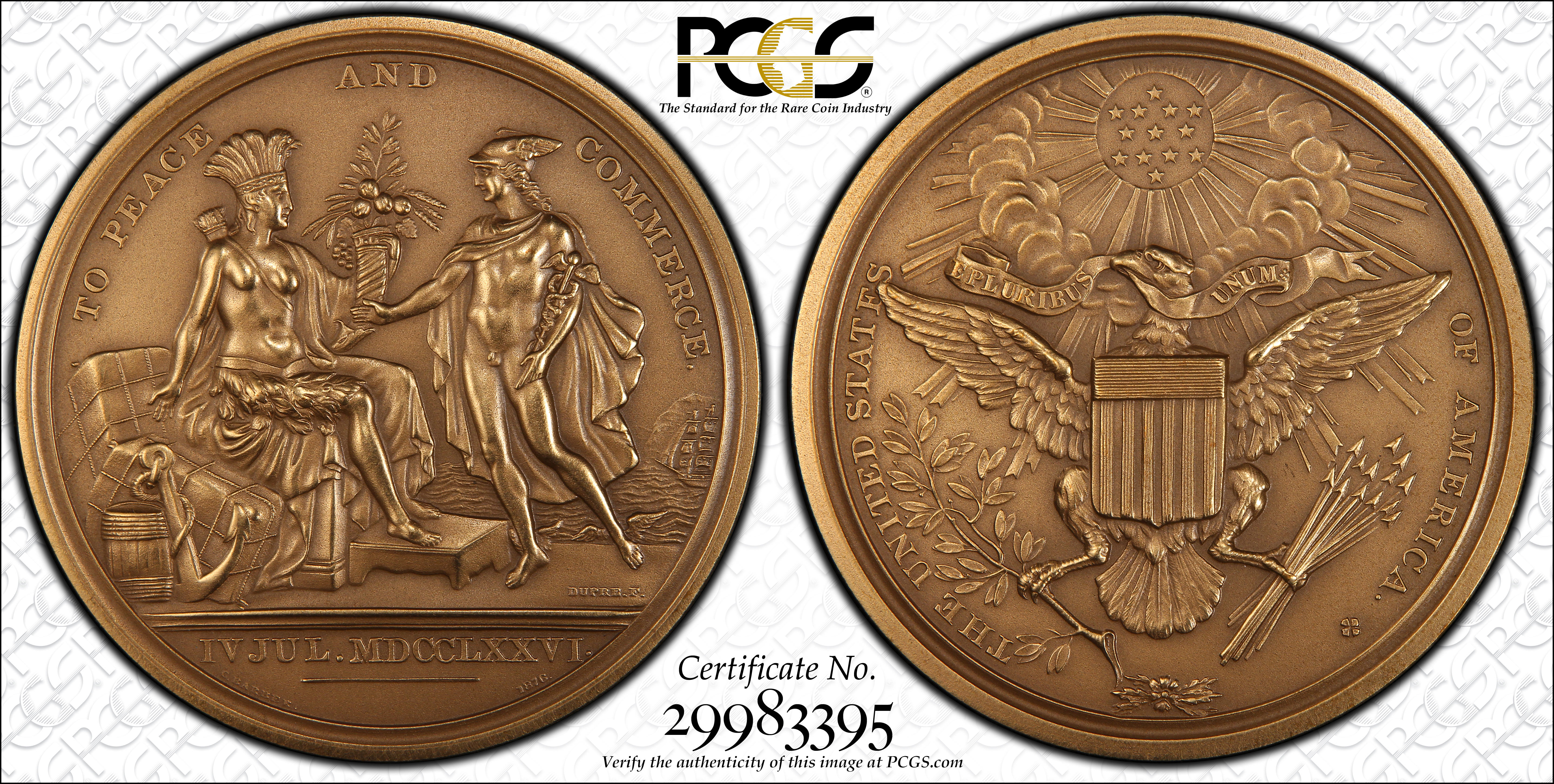Mahogany versus the “yellow bronze” finish for medals and the Nathaniel Greene medal
During much of the 19th century, the Philadelphia Mint issued medals that had a mahogany finish. Sometimes it was a rich dark brown that overlaid Proof-Like surface. These metals were very beautiful, but along about the late 1890s, it started to change.
In place of the mahogany finish, the mint started to sandblast the surfaces of the pieces which gave them a duller, matte finish. The resulting metals were not nearly as nice in my opinion. In some cases, the medals ended up with a “yellow bronze” look, which I find particularly unattractive. Here is an example of the “yellowest” of “yellow bronze.”


Sometimes even the experts are fooled when it comes to telling the difference between a mahogany finish medal from an earlier date and sandblasted piece that was made later or some times much later. But first, a bit of history.
Nathaniel Greene is one of the unsung heroes of the Revolutionary War. Prior to the war he was a member of the Society of Friends or “Quaker.” The Quakers are opposed to violence, and when Greene chose to support the army in the Revolutionary War, the Society of Friends expelled him from their group. An educated, largely self-taught man, Greene learned about the military and tactics by reading books.
Greene joined the Continental Army and ultimately became one of George Washington’s able and most trusted officers. Washington promoted him to major general in 1776. He served under Washington during the New Jersey and Philadelphia campaigns. He would serve as the third Quartermaster General of the Army from 1778 until 1780.
In 1780, the British moved the focus of the war from New York and the Mid Atlantic states to the south. There they were at first very successful, easily besting American generals Robert Howe, Benjamin Lincoln and Horatio Gates. Washington sent Greene south to try to pick up the pieces.
Despite the fact that he never won a battle, Greene performed brilliantly. He kept the British Army off balance and lured them further into the American heartland where they lost men and materials that they could not replace. His most famous battle was a Guilford Court House for which the Continental Congress voted to award him this medal in gold.
Ultimately the British Army, under Cornwallis, worked their way to Yorktown where they were caught in a vise between the allied American and French Armies and the French Navy. Cornwallis was forced to surrender which in actuality ended the Revolutionary War although the Americans would have to maintain their guard for another attack for the next couple of years.
Years ago, I bought this Nathaniel Greene in medal. The dies for the original Nathaniel Greene soon after it was struck. Julian stated in his book, “Medals of the United States Mint, the First Century, 1792 – 1892” that the dies were presented to Nathanial Greene’s widow for reason that I cannot understand. Most all of the pieces that are available to modern collectors were struck from a new set of dies that were made in 1886. A small number of those coins have the mahogany finish (the report mintage is “40 records”), but this is not one of them. It is a sandblasted piece that either toned on its own or had a bit of help. The dealer who sold it to me took it back for a full refund a few years after the sale, much to his credit.


And here is one of the original, mahogany finish medals.


Comments
Nice medals and history. It's always nice to see the old mahogany finish medals. Good info on the finishes and the dies. Are the whereabouts of the dies or his gold medal known now? They would be an amazing items.
Regarding the yellow bronze satin finish, I'm also generally also not a huge fan of the modern satin finish for coins and prefer the older business strike finishes. For me, the older finishes have more character since they often have more variation, but a goal of a modern mint may be more uniformity and perfection.
There's some great info on Nathanael Greene and his wife, Catharine Littlefield Greene, on Wikipedia. Although Nathanael was a war hero, the war also left his family bankrupt because he was conned when personally guaranteeing payment to Charleston merchants to clothe the Southern Army. The debts were cleared by George Washington in 1792, six years after Nathanael died of sunstroke in 1786.
Great post @BillJones.... Very interesting.... and a personal note for me.... After I left the Navy, I went to work for a while in the Portsmouth Naval Shipyard. I was assigned to the USS Nathaniel Greene, SSN 683... A new nuclear sub being built and I worked on it until it launched... and was aboard for the launch. Great experience... though, at one point during the build, I almost was asphyxiated due to lack of oxygen, when I was in the bottom of the ship putting in a pipe and a freon leak from a test system leaked. It evaporated as it ran down the hull, but it is heavier than air and accumulated where I was working. It was close, but with help, got out and none the worse for wear. Cheers, RickO
Daniel Morgan won at Cowpens. He was a brilliant general. I must agree that the earlier medals were nicer though, but Morgan deserves more credit than Greene as he had a battle plan other than line up and shoot em out. Greene was good, Morgan was better imo.
Thanks Bill, for another very informative post. Add me to the list of collectors who prefer the mahogany finish.
Morgan had an outstanding day at the Battle of the Cowpens, but by that time he was physically spent. He was suffering so badly from rheumatism that he could barely ride a horse. After the battle he had retire from the field and would no longer be a factor in the war.
Like Washington, Greene learned to be a “hedgehog.” He stayed in the weeds until it was time to come out, inflict punishment upon the British Army and then melt into the countryside until the next opportunity came along. Greene was a much more important factor in the southern portion of the war.
He also played a major role on Washington’s staff before the sourthern campaign. Morgan couldn’t stand Hortio Gates, for good reason, and sat out the war for a while after the Battle of Saratoga until he got involved again in the southern phase of the war.
I prefer the mahogany color to the "yellow bronze" the U.S. mint has used.
Here's another comparison, using the newly-made 1876 dies for the Diplomatic Medal:
Mahogany, circa 1876:

Yellow Bronze, circa mid-1900's:

Speaking of the Cow Pens medal, which I think has the best design of all the Comitia Americana medals, here are two takes on the 19th century finish.
This medal was struck by the French Mint, circa 1838
This one was struck by the Philadelphai Mint from the same die pair circa 1860
It is almost impossible for a collector to obtain an example of Morgan Cowpens Medal struck from the original dies. They were lost soon after the original medals were struck.
In the late 1830s, the original gold medal that was awarded to Morgan was stolen. The family asked the government for a replacement. I believe that the French Mint made a set of copy dies using the silver coin that is now in the set held by the Massachusetts Historical Society. The French copy dies are virtually identical to the original design. They were used to strike a new gold medal for the Morgan Family and to make a few pieces in other metals, including the bronze piece I posted above.